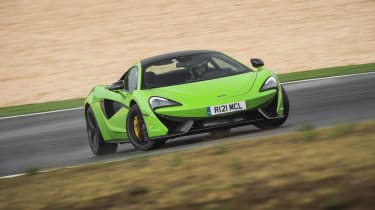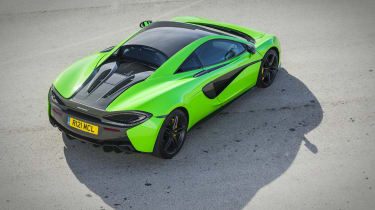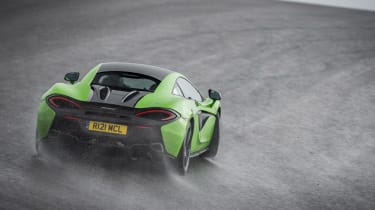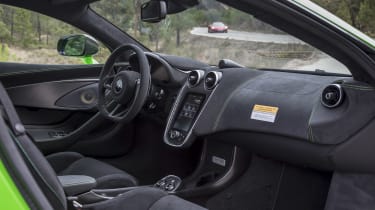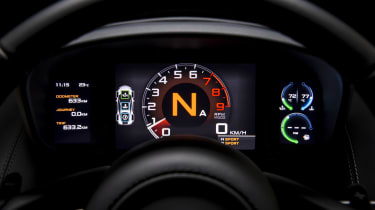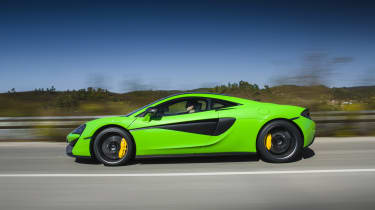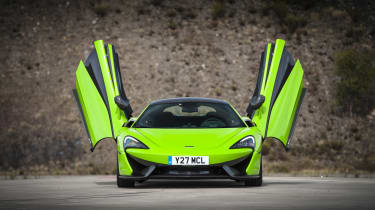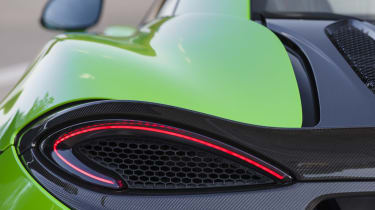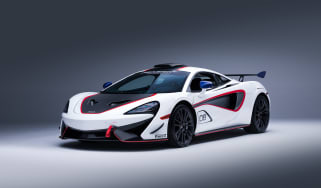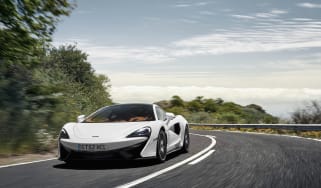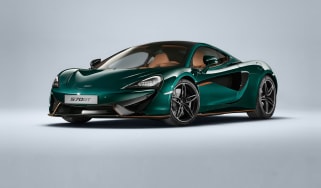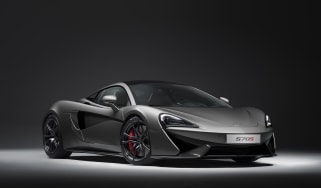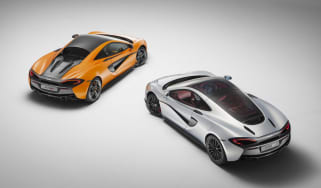McLaren 570S (2012-2022) review - alert, engaging, better than an Audi R8?
An immersive and involving supercar that promotes enjoyment above all else.
The 570S was the first model released in McLaren’s entry-level Sports Series range, which slots in beneath the GT, Super and Ultimate Series. The Sports Series has since grown in all directions, with an entry-level 540C, Spider, 570GT and eCoty-winning 600LT topping it off, but the 570S remains the core model to tempt you away from fellow mid-engine junior supercars like the Audi R8 and Lamborghini Huracan, while not being a million miles away from high-end sports models like the Porsche 911 Turbo S and Aston Martin Vantage.
The Sport Series was tasked with more than doubling McLaren’s overall road car output to more than 4000 units per year – something it has since struggled to achieve despite the full range of variants now available.
There’s no reason to associate the model’s commercial success with its technical capability though, as the 570S has since created a dynamic benchmark for the marketplace at this level. It might lack the powertrain theatrics of a Lamborghini, or the inexorable quality of a 911 Turbo or Audi R8, but its combination of supercar looks, unimpeachable chassis and that little bit of exotica continue to make it an extremely attractive performance car proposition.
More reviews
Reviews
- McLaren 620R (2018 – 2020) review – McLaren's ultimate road racer made the 600LT look soft
- Litchfield McLaren 570GT review – UK tuner lifts output to 720bhp
- McLaren 570GT Sport Pack review – the best of both worlds
- McLaren 570S Spider 2017 review - has the roadster got the Sports Series sparkle? (video)
- McLaren 570S Track Pack review - lightweight additions make for one of McLaren's best cars yet
The 570S is nearing its expiration date, but its incumbent successor has been delayed until 2021, and if the rumoured V6 hybrid powertrain is particularly distasteful to you, now might be exactly the right time to get your hands on this genuine junior supercar.
Engine, transmission and 0-60mph time
The 570S uses the same Ricardo-sourced twin-turbo V8 that serves throughout the McLaren line-up – right up to the £1.98m P1 GTR.
Compared to the 650S’s 3.8-litre power unit the engine is 30 percent different with new internals and valve gear. In this application it’s rated at 562bhp at 7500rpm and 443lb ft from 5000rpm the 570S’s engine; some way down on the old 650S’s (641bhp and 500lb ft), but keeps the same high redline and linear torque curve. The flat-plane crank V8 uses a dry sump lubrication system and a stop-start function is included.
The gearbox is the familiar seven-speed twin clutch unit, or Seamless Shift Gearbox in McLaren speak, driving the rear wheels through an open differential. The engine and gearbox can be switched from Normal mode into Sport or Track to improve response and cut shift times. The 570S manages 0-60mph in 3.1 seconds and has a top speed of 204mph.
Technical highlights
Like all McLarens, the 570S is built around a very light, stiff carbon fibre tub. Called MonoCell II, the chassis is similar to that of the 650S but it’s been adapted to improve access to the cabin – the Sports Series is billed as an everyday sports car rather than an occasional use supercar, after all. Notably, 80mm has been trimmed out of the sill height to ease ingress and egress.
The tub weighs just 75kg and McLaren claims it’s 25 per cent stiffer than an equivalent aluminium structure. Front and rear subframes, made from aluminium, carry the drivetrain and suspension components.
The 570S’s dry weight, with certain lightweight options, is quoted at 1313kg – add another 100kg or so for a kerb weight. That figure undercuts the Porsche 911 Turbo S by some 227kg and the Audi R8 Performance by 282kg – huge figures that are in large part thanks to its carbon tub construction.
Dimensionally the 570S is only marginally smaller than the 720S, but it is a fair amount more compact than the new GT, which has been designed in essence to replace the closely-related 570GT, albeit at a higher £163,000 price point.
One of the primary points of difference between Sports Series and Super Series models in chassis terms is the use of conventional anti-roll bars rather than the complex ProActive Chassis Control system that has come to define high-end McLarens. The ProActive system links the dampers hydraulically to decouple, to some extent at least, ride and roll stiffness. The simpler anti-roll bar solution serves as a point of difference to the rest of the McLaren line-up and also reduces complexity and cost.
The car runs on double wishbones all round with three-way adaptive dampers, offering Normal, Sport and Track modes to reflect the powertrain options. In 2017, McLaren released an optional track pack for the 570S which combined a selection of lightweight options and the 570GT's rear lip spoiler together.
The 570S does without active aerodynamic components, but the frontal area, rear diffuser, flying buttresses and bodywork have all been carefully designed to reduce drag, precisely direct cooling air or create downforce.
What’s it like to drive?
What first stands out on the road is the impressively pliant and relaxed ride quality. In Normal mode the 570S is hugely comfortable, both around town and on the motorway, with none of the crashiness that you might expect of a car with such dynamic ability.
The gearbox, meanwhile, works without fuss in automatic mode and the sound of the engine is well subdued. This is car would be no more taxing in daily use than an Audi R8 or Porsche 911 Turbo apart from the fact that, despite the reprofiled carbon tub, it’s still a slightly tricky car to get into and out of. The cabin quality is good for the most part – although the satellite navigation did frequently confuse itself.
McLaren offers Sport and Luxury trim levels for the cabin. Naturally we’d recommend the Sport option, and with it the optional sports seats. They offer superb support in hard driving, but they’re also perfectly comfortable over a long journey.
The 570S has the sweetest chassis of any car in this class. Ramp the handling and powertrain modes up to Sport and the 570S becomes a responsive, agile and rewarding car. That impressive ride quality translates into pliancy and suppleness when you push a little harder, so the car rides over bumps without being thrown off course and lands with real control into compressions.
The clever bit is it the body always remains tautly controlled, never feeling as though that pliant setup has been achieved simply by winding off the spring rates. With such tight-fisted body control the 570S is alert and agile, finding good bite on its Pirelli P Zero Corsa tyres.
> McLaren 570GT Sport Pack review
On turn in the front axle grips hard and the car resists roll, so it feels urgent and precise into a corner. The steering is also crisp and direct, with a strong sense of connection to the front axle once the chassis has been loaded up. At corner exit, the car finds good traction despite the lack of a limited slip differential.
With the ESC system knocked back to its Dynamic setting you can also revel in the chassis’ natural balance, applying the throttle confidently and early to provoke the rear axle into swinging around progressively. This is a much more playful car than a 650S – completely by design – and that makes it more fun on a twisting road. Much of that is down to its more progressive, less critical transition from grip to slip.
The carbon ceramic brakes serve up very strong stopping power, but the brake pedal itself feels wooden and lifeless anywhere short of full force.
The gearbox swaps cogs quickly and cleanly in manual mode, as you’d expect of a twin-clutch unit. The twin-turbocharged V8 is familiar from the defunct 650S, despite its 30 per cent new parts, which means it needs a moment to wind itself up from below 3500rpm, but above that it’s sharp and response with huge performance and an energetic run to the far side of 8000rpm.
Price, specs and rivals
McLaren’s most focused Sports Series car is priced from £150,815, and that's before you address the extensive options list. Furthermore, if you want the Spider version the price jumps to £165,000. The 570S bridges the gap between the entry-level and range-topping Sports Series models in the shape of the McLaren 540C and McLaren 600LT respectively.
When it comes to configuring a 570S, restraint is necessary – the scope for costly customisation is endless. To gain some exclusivity you may spend extra on the paintwork: blue and silver are the only cost-free finishes of the 35 choices listed ranging from £1500 to near five figures.
McLaren also offers plenty of carbonfibre addenda with individually specified options and packages. One example is the Carbon Fibre Exterior Pack 2, which includes aero blades, side skirts and a diffuser, all made from carbonfibre, which adds almost £10k to the bottom line. Should you want the lightweight material to trim your interior, too, McLaren will equip you with the (£5k) Carbon Fibre Interior Pack.
evo considers the security pack essential, despite its £4k price tag. The added convenience of vehicle lift, front and rear parking sensors and a rear view camera are welcome extras that make the 570S easier to live with, especially in urban environments.
Porsche’s new 911 Turbo S and Audi’s R8 V10 Performance provide compelling alternatives priced within range of the 570S. Both utilise a four-wheel drivetrain, however they deliver unique driving experiences.
The R8 subscribes to the traditional supercar formula – and is all the better for it – locating a naturally aspirated engine within its wheelbase. Its high-revving, howling 631bhp V10 accounts for much of the appeal, offering a rare experience in a world of downsized, turbocharged engines. Priced from £139,850, it still undercuts its rivals though.
The new 992-generation £155,970 Turbo S is at another level of performance, with claimed figures easily out-stripping all of its major rivals at 2.6sec to 62mph and 640bhp. More than just a point and squirt super sports car, the new Turbo S is also the most entertaining, the most effervescent and desirable it’s been in a generation.
The latest Lamborghini Huracan Evo RWD is also within touching distance at £165,256, and even if you’re not the biggest fan of the theatre that constantly follows the Italian supercar around, is a lot of V10 supercar for the money.
